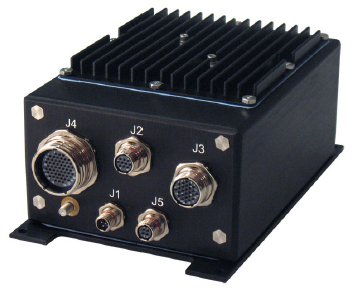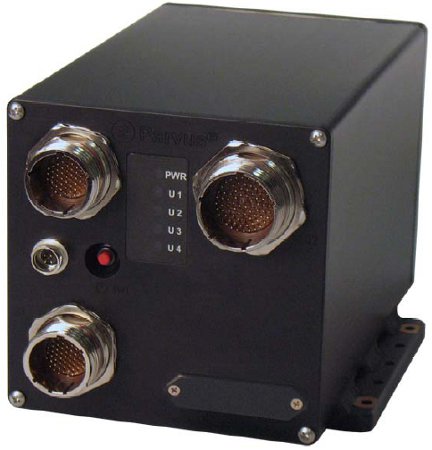Compact tactical PC taps Atom CPU
Feb 2, 2010 — by Eric Brown — from the LinuxDevices Archive — 2 viewsEurotech subsidiary Parvus announced an Intel Atom-based version of its rugged, Linux-ready tactical mission computer. The DuraCOR 820-A offers an Atom Z530 1.6GHz processor with gigabit Ethernet and optional MIL-STD-1553 databus connectivity, as well as lower power consumption, and additional memory and storage compared to the previous model, says Parvus.
 Parvus introduced the original DuraCOR-820 in Feb. 2008, equipped with an Intel Pentium M738 clocked at 1.4GHz. In September of last year, Parvus announced a successful test flight for the Aurora Excalibur (pictured at right), an unmanned attack drone using two Linux-based DuraCOR 820 PCs.
Parvus introduced the original DuraCOR-820 in Feb. 2008, equipped with an Intel Pentium M738 clocked at 1.4GHz. In September of last year, Parvus announced a successful test flight for the Aurora Excalibur (pictured at right), an unmanned attack drone using two Linux-based DuraCOR 820 PCs.
The DuraCOR 820-A offers only slightly higher processing power than the previous DuraCOR 820, but by using an Intel Atom Z530 (one of the original Atom models) clocked at 1.6MHz instead of the previous 1.4MHz Pentium M738, it is said to consume less power.
Compared to the previous 22 Watts maximum draw, the DuraCOR 820-A consumes a maximum of 16-19 Watts, depending on the presence of an optional new MIL-STD-1553 port. The 28V power supply is said to be compliant with MIL-STD-1275 and MIL-STD-704 voltages, spikes, and surges, making the unit compatible with both airborne and military ground vehicle platforms.

Parvus DuraCor 820-A
A single gigabit Ethernet port replaces the previous dual fast Ethernet ports, and the computer maintains the previous three USB 2.0 ports and two RS-232 ports. Other I/O includes PS/2, DIO, and VGA connectivity, as well as the aforementioned optional MIL-STD-1553 port, which offers military-class databus connectivity, according to Parvus.
As with the previous model, all this I/O is brought out through lightweight, high-density MIL-38999-like connectors, making the product suitable for unmanned and manned command and control (C2) applications, says the company. The system is also said to be built on a PC/104-Plus board architecture, enabling customized I/O.
The DuraCOR 820-A offers the same rugged, fanless mechanical design as the 820 model, measuring 3.0 x 4.3 x 7.0 inches and weighing about three pounds. The conduction-cooled chassis supports temperatures ranging from -40 to 160 degrees F (-40 to 71 deg. C) and meets other MIL-STD-810F environmental conditions for thermal, shock, vibration, altitude, and humidity, says Parvus.
In addition, the 820-A model is said to offer enhanced ingress protection from dust and water immersion, along with improved filtering and shielding from EMI/EMC conditions. The system meets and will undergo MIL-STD-810F and MIL-STD-461E environmental and emissions/susceptibility qualification testing as it prepares for production, says the company. More images of the computer may be found below, at right.
 The following specs are listed for the DuraCOR 820-A:
The following specs are listed for the DuraCOR 820-A:
- Processor — Intel Atom Z530 @ 1.6GHz
- Memory — 2GB DDR RAM
- Flash storage — 4GB integrated SSD; 16GB CompactFlash SSD
- Video — VGA analog output (up to 1600 x 1200)
- Networking — 1 x 10/100/1000Mbps Ethernet
- Other I/O:
- 3 x USB 2.0
- 2 x RS-232 serial
- 4 x GPDIO inputs
- 4 x GPDIO outputs
- PS2 keyboard and mouse ports
- 1x MIL-STD-1553 port, (optional) with DDC BC/RT/MT
- Dimensions — 3.0 x 4.3 x 7.0 inches (75.95 x 109.22 x 177.8 mm)
- Weight — 3 lbs (1.36 kg)
- Chassis — corrosion-resistant aluminum alloy, anodized per MIL-A-8625, Type II, Class 2; flange mount baseplate
- Power:
- 28VDC nominal power
- 16 Watts max dissipation (19W with MIL-STD-1553 port)
- Reverse, over voltage, surge protected
- MIL-STD-704E and MIL-STD-1275D compliant
- Temperature range — -40 to 160 degrees F (-40 to 71 degrees C); MIL-STD-810F compliant
- Humidity range — 5% to 95% (non-condensing); 100% (condensing); MIL-STD-810F compliant
- Operating shock — 20g, 15ms, 3 positive/negative per axis; MIL-STD-810F compliant
- Crash-safety shock — 40g, 11ms, 2 pos/neg per axis
- Random vibration — 0.22-G(squared)/10-Hz to 0.0026-G(squared)/2000-Hz
- EMI/EMC — MIL-STD-461E compliant
- Altitude — 60,000 feet (18,288 meters); MIL-STD-810F compliant
- Dust, water, and moisture resistance — IP65 and NEMA 4 compliant
- Operating system: Linux or Windows XP Embedded (120-day evaluation license)
DuraCor 810-Duo
In addition to announcing the DuraCOR 820-A upgrade, Parvus also announced it is now deploying the higher-end, Linux-ready DuraCOR 810 Duo tactical computer, which it announced back in Nov. 2008. Sporting an Intel L7400 Core 2 Duo clocked at 1.5GHz with 2GB of memory, the DuraCOR 810-Duo is far more expandable than the 820 models, offering six expansion slots for PCI-104 or PC/104-Plus modules, plus an expansion connector that is said to be pre-routed for optional add-on cards.

Now shipping: DuraCOR 810-Duo
The DuraCOR 820-A is currently in pre-production, and pricing is not yet available. MIL-STD qualification testing should begin later in the first quarter, with production to follow. More information may be found here.
The DuraCor 810-Duo (pictured directly above) is now shipping. More information may be found here.
Both products are being shown at booth #1411 of the AFCEA/USNI West 2010 Conference in San Diego, starting today through Feb. 4.
This article was originally published on LinuxDevices.com and has been donated to the open source community by QuinStreet Inc. Please visit LinuxToday.com for up-to-date news and articles about Linux and open source.